On the Radio
As I have mentioned in previous posts, Antarctica is the coldest, windiest, and driest of the seven continents and, as a result of its extreme conditions, has a very small and limited population. In fact, McMurdo Station (the largest of the three US bases on Antarctica) typically averages less than a thousand residents during the summer season and drops to less than a hundred during the winter season. But these extreme conditions and small number of residents do not mean that there is little or nothing to do during a stay at McMurdo Station. On the contrary, there are quite a few things to do while at McMurdo Station.
One event that is quite popular on Sunday and Wednesday evenings is a science talk by one of the researchers conducting research, or videographers documenting natural phenomena in Antarctica. Last Sunday, I went to hear a talk by Michael Becker, part of a film crew from the BBC who were filming scenes for an upcoming program, Seven Worlds, to air in the UK in 2019 and in the U.S. in 2020. The presentation was standing room only and the samples of video shot while on location were simply amazing. One question posed of Mr. Becker following the presentation had to do with the length of footage required to observe the rare phenomena in nature. He replied that it was 100 to 1. In other words, for 100 minutes of footage captured on video, about 1 minute makes it into the final program.
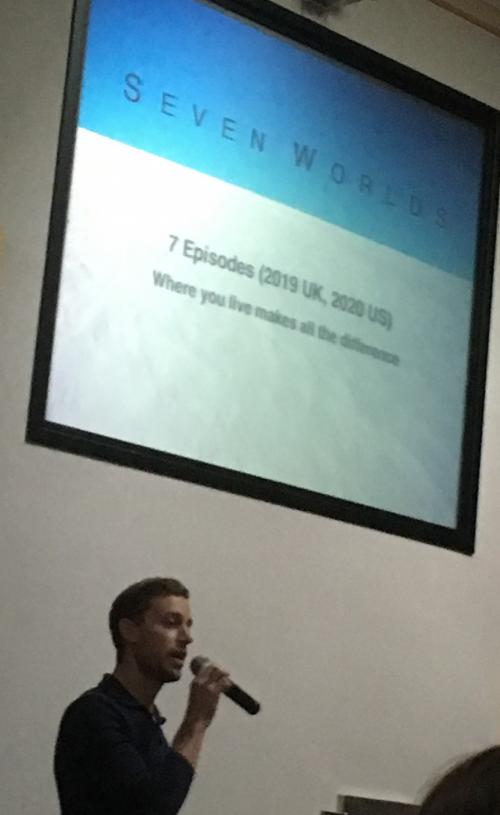
Yet another opportunity which is a sensation among residents of McMurdo Station is the Observation Tube (referred to in these circles as the Ob Tube).
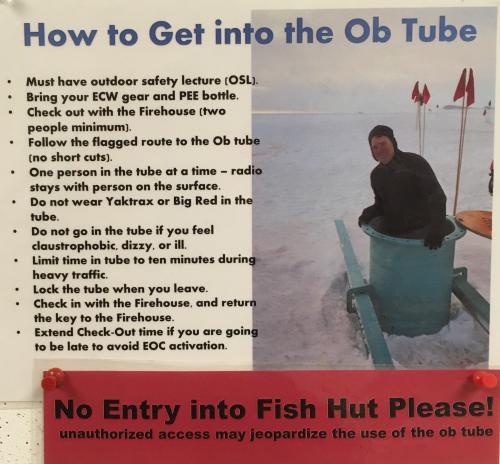
The Ob Tube is essentially a hole about the diameter of a manhole cover that extends down into the Ross Sea. At the bottom of the tube is a place to sit, completely surrounded by Plexiglas. The Ob Tube is small in that only one person can descend the tube at a time, but you are allowed down the tube only if you are with at least one other person. The Ob Tube is covered by a lid which is secured by a lock and can only be unlocked with a key distributed by the Fire Station. I was with Carol and two other colleagues who all decided to take the short trip to enter the Ob Tube. The Ob Tube, at first glance, looks like an elevated manhole similar to those descended by city workers to inspect infrastructure from below the city streets.

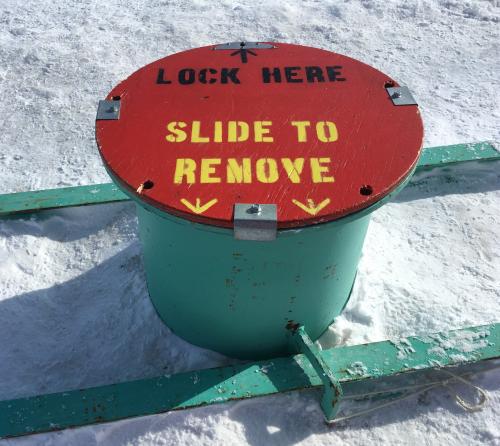
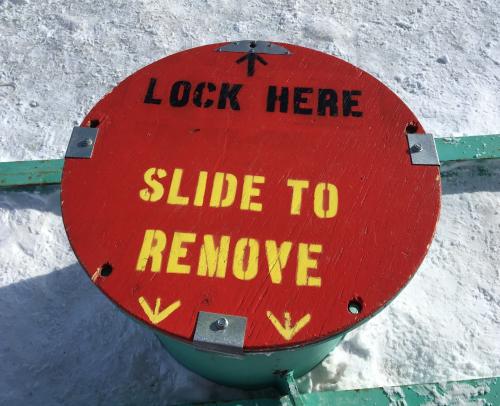
I removed the cover lid to the Ob Tube and slowly began to descend the steps toward the viewing station at the bottom. As I made my way down the tube, the lid, which was kept off the top of the entrance until I made my way to the bottom, was placed back on once I made it to the bottom to eliminate the light coming from above. This way, you could clearly see any features or wildlife that might be lurking below the surface of the Ross Sea.
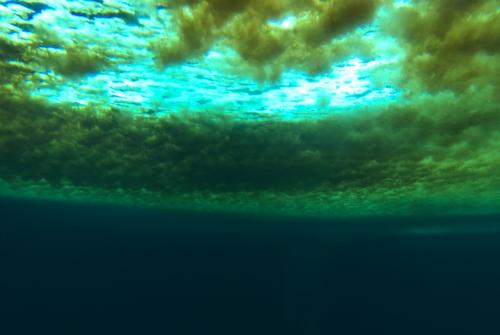
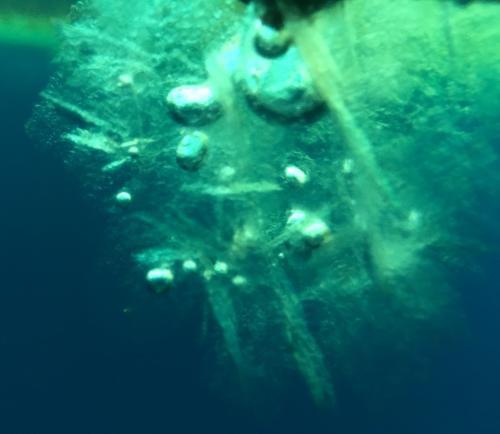
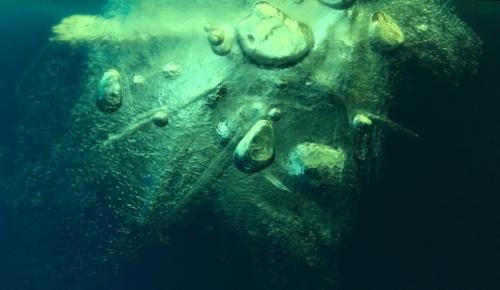
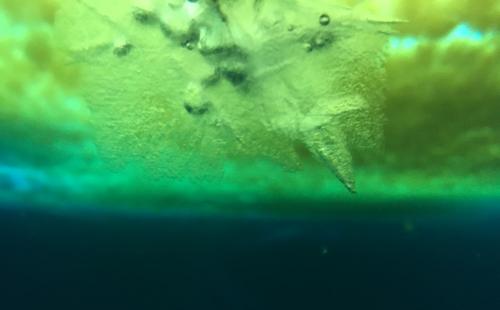
The Ob Tube is such a cool opportunity (again, pun intended) but, as the informational poster stressed, definitely not for those who are claustrophobic.
Now, I am sure you are wondering what all of this has to do with the topic of today’s journal entry. Well, I’m getting to that. The point I am trying to make is that there are many things to do – many of them posted with notices on Highway 1 – the main hallway in the Galley. As you can see, there is a monitor that alternates between different activities that you might consider participating during the day.
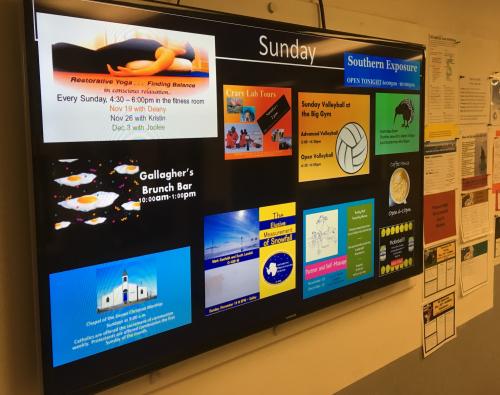
Usually on the way to breakfast in the morning, I will take time to read all of the different programs and opportunities available to McMurdo residents. One morning, there was a notice that caught my attention.

The community radio station, ICE 104.5, is always looking for volunteer DJs to take over a shift and play music on the radio. This sparked my interest because, as you know if you have been following my posts, I used to be a radio announcer throughout my years in college. I have always loved being behind the microphone, listening and playing all types of music and of course, talking. So, I put my name on the sign-up sheet and waited for next steps.
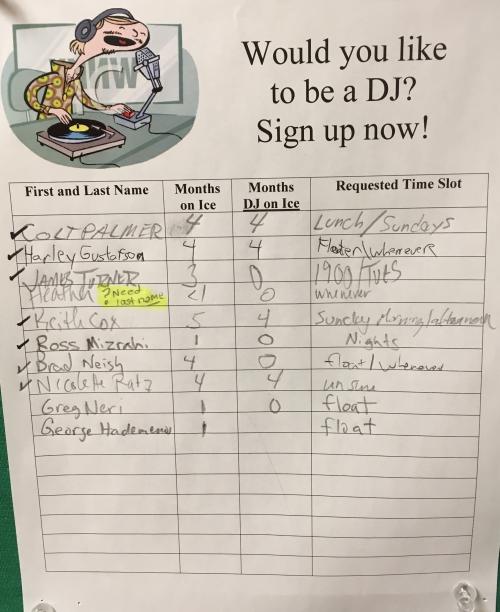
The next day, I received an e-mail from Joolee, Station Manager, thanking me for the interest and informing me about an orientation session that took place on Thursdays and Saturdays from 9:00 am – 10:00 am. It would turn out that Thursday would work for me as our flight out to the field got cancelled due to weather. I showed up, was given a tour of the Vinyl Room, a prized possession which contains thousands of vinyl records of all types of music and all types of genres. When I was working in radio, vinyl records were the common platform of music while recorded tape was making its entrance. Now, vinyl records almost seem like a relic of the Stone Age and, if that’s the case, call me Fred Flintstone. Anyway, we then proceeded to the studio and discussed the control panel which controls two microphones, two CD players, a turntable for the vinyl records, and an automated system which allows you to pick and choose from an assortment of songs from a computer monitor.

We went back and forth practicing use of the microphone and playing music from each of the various platforms. Following the orientation, we were then required to sit in with an experienced DJ who would then give us extra time behind the seat of the control panel. There was an opportunity to sit in with such a DJ at 1:00 pm later that afternoon, so I returned for the next step of the process. I got to the control room about 10 minutes before 1:00 pm and was waiting outside when the guy shows up in a t-shirt, pajama bottoms and bear pawprint slippers. How can such a person not make you crack a smile?
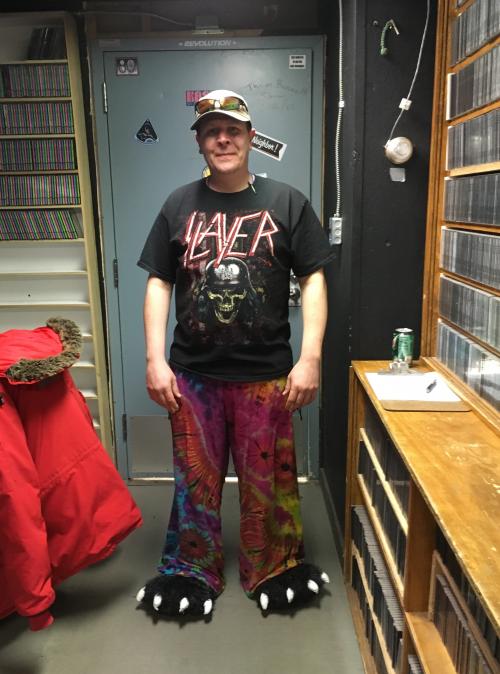
Doug Rhoades, also known as Doogles, was the DJ on the air. We had a nice conversation about his tenure as a DJ at McMurdo and the circumstances that brought him here. As we got started, I donned the headphones and got behind the microphone to say a couple of words.
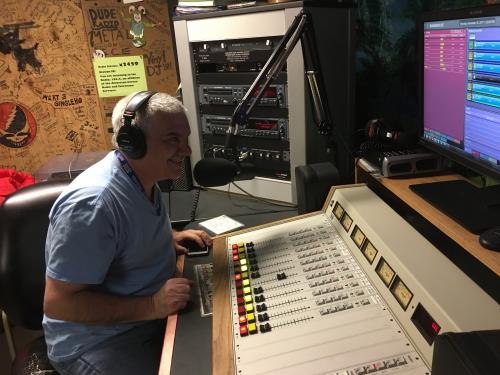
I then got to select three songs to play from the automated system – yeah, I’m pleased with the choices which would get played during my shift.
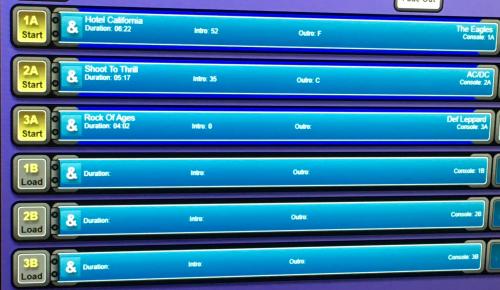
While I was being trained, Doug was still the DJ on the air and he is known for his on air mantra, Ask Doug anything! He is often encouraging listeners to phone in questions that he will try to find an answer to. One such caller phoned in during our training session to ask: Do cows swim? He set to find out the answer and offer his reply later during the shift. It turns out that not only can cows swim, they can walk upstairs and, under the right circumstances, walk downstairs as well. To be honest with you, I did not know this. You learn something new every day!
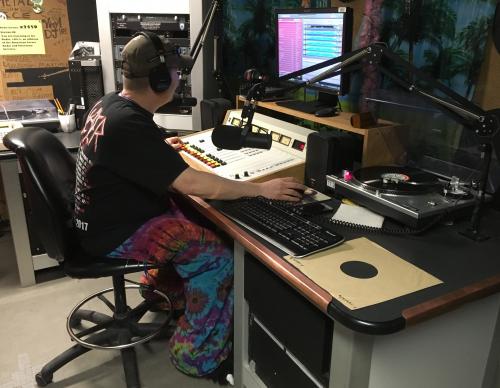
After an hour and a half, I had to leave to attend a meeting with a scientist at Crary Lab. I so much appreciated the opportunity to meet Doug and train to be a volunteer DJ. Now that I am trained, I am qualified to take on a shift. I have yet to sign up for a shift as my time is dwindling at McMurdo and want to be ready if and when a flight becomes available. If I am able to squeeze in a shift, that would be “over the top.” If not, I am still appreciative of being able to train and to bring back great memories of my time on the radio 32 years ago.
Coming Up Next: The frequent cancellations of helicopter and Twin OtterA highly maneuverable utility aircraft developed by de Havilland Canada. It can be flown slowly and in tight circles, and is designed for 20 passengers, short takeoffs and landings, and often used for cargo, passengers, and as a science platform. flights out to the AWS sites does not necessarily mean I have been kept out of the field. There are AWS sites that are close enough that we can drive to them. In the next entry, we travel to one such site. And, don’t worry, Kiwi, I haven’t forgotten about you. You’re up next as well! I promise.


Comments